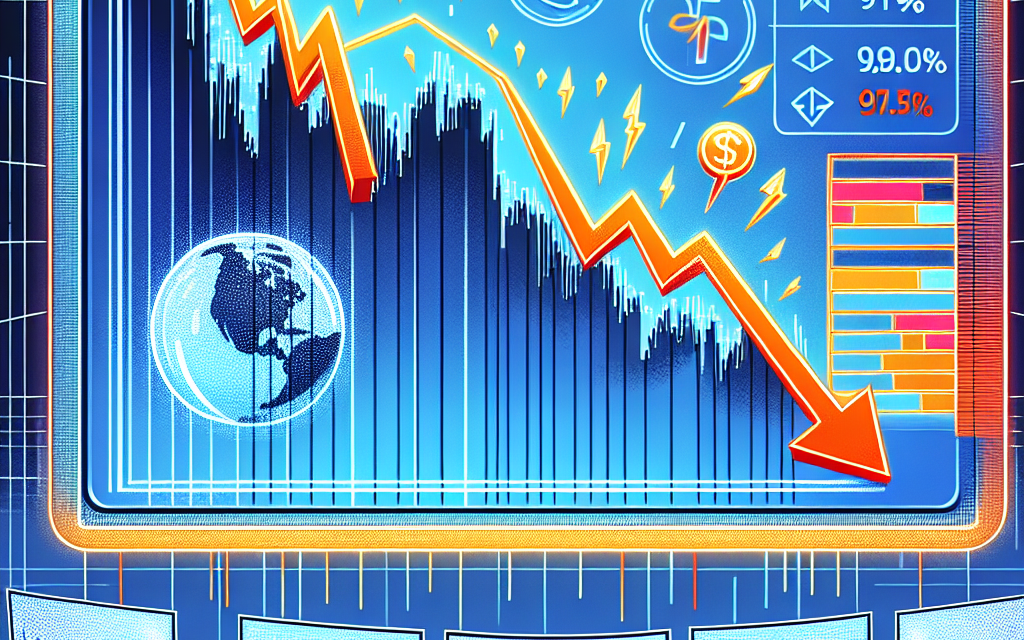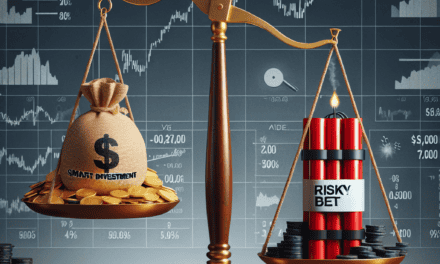“Market Shock: Dow Plummets 700 Points Amidst Conflicting Economic Signals.”
Introduction
On a day marked by significant market volatility, the Dow Jones Industrial Average experienced a sharp decline, dropping nearly 700 points despite the release of positive economic indicators. This unexpected downturn has left investors and analysts puzzled, as strong data on employment and consumer spending typically bolster market confidence. Factors contributing to this decline may include rising inflation concerns, geopolitical tensions, and shifts in monetary policy, which can overshadow favorable economic news. Understanding the interplay of these elements is crucial for grasping the complexities of the current financial landscape.
Market Reactions to Economic Data
In recent trading sessions, the Dow Jones Industrial Average experienced a significant decline, dropping nearly 700 points despite the release of positive economic indicators. This paradoxical market reaction raises questions about the underlying dynamics influencing investor sentiment and market behavior. While one might expect favorable economic data to bolster market confidence, the reality is often more complex, as various factors interplay to shape investor reactions.
To begin with, it is essential to recognize that financial markets are not solely driven by current economic conditions; they are also influenced by expectations about future performance. For instance, although recent reports indicated robust job growth and rising consumer spending, investors may have interpreted these indicators as signs of an overheating economy. Such a perception can lead to concerns about potential inflationary pressures, prompting speculation that the Federal Reserve might adopt a more aggressive stance in tightening monetary policy. Consequently, fears of increased interest rates can overshadow positive economic news, leading to a sell-off in equities.
Moreover, market participants often react to economic data through the lens of broader geopolitical and macroeconomic contexts. In this instance, ongoing global uncertainties, including geopolitical tensions and supply chain disruptions, may have contributed to a cautious outlook among investors. Even as domestic economic indicators appear strong, external factors can create a sense of unease, prompting traders to reassess their positions. This phenomenon illustrates how interconnected the global economy is, where local data can be overshadowed by international developments.
Additionally, the psychological aspect of trading cannot be overlooked. Investor sentiment plays a crucial role in market movements, and fear can often drive decisions more powerfully than optimism. In the face of fluctuating economic signals, traders may opt for a risk-averse approach, leading to increased volatility. The recent drop in the Dow may reflect a broader trend of profit-taking, where investors, having enjoyed substantial gains in previous months, decide to lock in profits amid uncertainty. This behavior can create a cascading effect, as one sell-off prompts others to follow suit, further exacerbating market declines.
Furthermore, the role of technology and algorithmic trading in modern markets cannot be underestimated. Automated trading systems often react to economic data releases within milliseconds, amplifying market movements. In this context, even minor fluctuations in sentiment can trigger significant sell-offs, as algorithms execute trades based on predefined criteria. This mechanized response can lead to exaggerated market reactions, as seen in the recent downturn.
In conclusion, the nearly 700-point drop in the Dow, despite positive economic indicators, underscores the complexity of market reactions to economic data. While strong economic performance typically instills confidence, a multitude of factors—including inflation concerns, geopolitical uncertainties, investor psychology, and the influence of algorithmic trading—can lead to unexpected outcomes. As investors navigate this intricate landscape, it becomes increasingly clear that understanding market dynamics requires a nuanced approach that considers both current data and the broader context in which it exists. Ultimately, the interplay of these elements will continue to shape market behavior, reminding us that the relationship between economic indicators and market performance is anything but straightforward.
Understanding Investor Sentiment
In the complex world of finance, investor sentiment plays a pivotal role in shaping market dynamics, often leading to movements that seem counterintuitive in light of prevailing economic indicators. Recently, the Dow Jones Industrial Average experienced a significant drop of nearly 700 points, despite the release of positive economic data. This phenomenon underscores the intricate relationship between investor psychology and market performance, revealing how perceptions can sometimes overshadow objective metrics.
To begin with, it is essential to recognize that investor sentiment is influenced by a myriad of factors, including geopolitical events, corporate earnings reports, and macroeconomic trends. Even when economic indicators suggest growth—such as rising GDP, low unemployment rates, and robust consumer spending—investors may react negatively if they perceive underlying risks or uncertainties. For instance, concerns about inflation, interest rate hikes, or potential geopolitical tensions can create a sense of unease, prompting investors to sell off their holdings in anticipation of a market correction.
Moreover, the current economic landscape is characterized by a unique set of challenges that can exacerbate negative sentiment. While certain indicators may reflect a healthy economy, other elements, such as supply chain disruptions and labor shortages, can lead to skepticism about the sustainability of this growth. Investors often weigh these conflicting signals, and when uncertainty prevails, it can trigger a wave of selling, as seen in the recent market downturn.
Additionally, the role of market psychology cannot be overstated. Behavioral finance suggests that investors are not always rational; instead, they are influenced by emotions and cognitive biases. Fear and greed are two powerful motivators that can lead to irrational decision-making. In times of market volatility, fear often takes precedence, causing investors to react swiftly to perceived threats. This reaction can create a self-fulfilling prophecy, where the act of selling leads to further declines, reinforcing negative sentiment and prompting even more selling.
Furthermore, the influence of social media and real-time news coverage has amplified the speed at which sentiment can shift. In today’s digital age, information spreads rapidly, and investors are constantly bombarded with news that can sway their perceptions. A single negative headline can overshadow a series of positive economic reports, leading to a collective shift in sentiment that drives market movements. This phenomenon highlights the importance of understanding the broader context in which economic indicators are released, as the narrative surrounding these indicators can significantly impact investor behavior.
In conclusion, the recent decline in the Dow, despite positive economic indicators, serves as a reminder of the complexities of investor sentiment. While economic data provides valuable insights into the health of the economy, it is the perceptions and emotions of investors that ultimately drive market behavior. As such, understanding the interplay between objective metrics and subjective sentiment is crucial for navigating the financial landscape. Investors must remain vigilant, recognizing that even in times of apparent economic strength, underlying fears and uncertainties can lead to significant market fluctuations. This awareness can help investors make more informed decisions, balancing their strategies with both the data at hand and the prevailing mood of the market.
The Role of Interest Rates in Market Fluctuations
Interest rates play a pivotal role in shaping the dynamics of financial markets, influencing everything from consumer spending to corporate investment decisions. When the Federal Reserve adjusts interest rates, it sends ripples through the economy, affecting the cost of borrowing and the attractiveness of various investment vehicles. In recent times, despite positive economic indicators, the Dow Jones Industrial Average experienced a significant drop of nearly 700 points, underscoring the complex relationship between interest rates and market fluctuations.
To understand this phenomenon, it is essential to recognize that interest rates are a critical tool used by central banks to manage economic growth and inflation. When the economy shows signs of strength, as evidenced by robust employment figures or rising GDP, the Federal Reserve may opt to increase interest rates to prevent overheating. Higher interest rates typically lead to increased borrowing costs for consumers and businesses alike, which can dampen spending and investment. Consequently, even in the face of positive economic data, the anticipation of rising rates can lead to market volatility as investors reassess their positions.
Moreover, the relationship between interest rates and stock prices is often inverse. As rates rise, the present value of future cash flows from investments decreases, making stocks less attractive compared to fixed-income securities. This shift can prompt investors to sell off equities in favor of bonds, leading to a decline in stock market indices such as the Dow. Thus, even when economic indicators suggest growth, the looming threat of higher interest rates can overshadow these positive signals, resulting in market downturns.
Additionally, the psychological aspect of interest rate changes cannot be overlooked. Investor sentiment is heavily influenced by expectations regarding monetary policy. If market participants believe that the Federal Reserve will continue to raise rates aggressively, they may preemptively adjust their portfolios, leading to increased selling pressure on stocks. This behavior can create a self-fulfilling prophecy, where the anticipation of rate hikes drives down stock prices, even in the absence of negative economic news.
Furthermore, the global economic landscape adds another layer of complexity to the relationship between interest rates and market fluctuations. In an interconnected world, changes in U.S. interest rates can have far-reaching implications for international markets. For instance, if the Federal Reserve raises rates, it may strengthen the U.S. dollar, making American exports more expensive for foreign buyers. This scenario can negatively impact U.S. companies that rely on international sales, further contributing to market declines.
In conclusion, the recent drop in the Dow, despite positive economic indicators, highlights the intricate interplay between interest rates and market fluctuations. As investors navigate the uncertain waters of monetary policy, the anticipation of rising rates can overshadow even the most encouraging economic data. This phenomenon illustrates the importance of understanding the broader economic context and the psychological factors that drive market behavior. Ultimately, while positive indicators may suggest a thriving economy, the specter of higher interest rates can lead to significant market corrections, reminding investors of the delicate balance that exists within the financial ecosystem.
Analyzing Sector Performance Amidst Market Declines
In the wake of the Dow Jones Industrial Average’s significant drop of nearly 700 points, it is essential to analyze the performance of various sectors within the market to understand the underlying dynamics at play. Despite the presence of positive economic indicators, such as robust job growth and rising consumer spending, the market’s reaction suggests a more complex narrative. This divergence raises questions about investor sentiment and sector-specific vulnerabilities that may have contributed to the overall decline.
To begin with, the technology sector, which has been a primary driver of market gains in recent years, experienced notable volatility. While companies in this sector have reported strong earnings and continued innovation, concerns regarding regulatory scrutiny and rising interest rates have led to increased caution among investors. As a result, many technology stocks saw significant sell-offs, reflecting a broader apprehension about future growth prospects. This reaction is particularly pronounced given the sector’s previous overvaluation, which has made it more susceptible to market corrections.
In contrast, the energy sector displayed resilience amid the market turmoil. With oil prices remaining elevated due to geopolitical tensions and supply chain disruptions, energy companies have benefited from increased revenues. However, even within this sector, there are signs of strain. The ongoing transition to renewable energy sources has created uncertainty for traditional fossil fuel companies, leading to mixed performance across the board. While some firms have adapted successfully, others are grappling with the dual pressures of maintaining profitability while investing in sustainable practices.
Moreover, the financial sector’s performance during this downturn warrants attention. Banks and financial institutions have generally fared well in a rising interest rate environment, as higher rates can lead to improved net interest margins. Nevertheless, the recent market decline has raised concerns about potential credit risks and the overall health of the economy. Investors are increasingly wary of the implications of a slowing economy on loan defaults and asset quality, which has led to a cautious approach towards financial stocks. This sentiment is compounded by fears of a potential recession, prompting a reevaluation of risk across the sector.
Additionally, the consumer discretionary sector has faced its own set of challenges. Despite positive economic indicators suggesting strong consumer spending, rising inflation has begun to erode purchasing power. As prices for essential goods and services continue to climb, consumers may shift their spending habits, prioritizing necessities over discretionary items. This shift could adversely impact retailers and other businesses reliant on consumer spending, leading to a reevaluation of their growth trajectories.
On the other hand, the consumer staples sector has demonstrated relative stability during this period of market decline. Companies in this sector, which produce essential goods such as food and household products, tend to be more resilient in the face of economic uncertainty. As consumers prioritize essential purchases, these companies often experience steady demand, providing a buffer against broader market fluctuations. However, even within this sector, rising input costs and supply chain disruptions pose challenges that could impact profitability.
In conclusion, the recent decline in the Dow, despite positive economic indicators, underscores the complexities of market dynamics and sector performance. While some sectors exhibit resilience, others are grappling with significant challenges that reflect broader economic uncertainties. As investors navigate this landscape, understanding the nuances of each sector will be crucial in making informed decisions amidst ongoing market volatility.
The Impact of Global Events on U.S. Markets
The recent decline of nearly 700 points in the Dow Jones Industrial Average, despite the presence of seemingly positive economic indicators, underscores the complex interplay between global events and U.S. markets. While domestic economic data, such as robust job growth and rising consumer confidence, typically bolster investor sentiment, external factors can significantly sway market dynamics. This phenomenon highlights the interconnectedness of global economies and the sensitivity of financial markets to geopolitical developments.
One of the primary catalysts for the recent market downturn was the escalating tension in international relations. Events such as trade disputes, military conflicts, or diplomatic crises can create uncertainty that permeates financial markets. Investors often react to these developments by reassessing risk, leading to increased volatility. For instance, news of heightened tensions in a key region can prompt fears of supply chain disruptions or economic sanctions, which in turn can negatively impact U.S. companies with global operations. Consequently, even positive domestic indicators may be overshadowed by the looming threat of international instability.
Moreover, the influence of central banks around the world cannot be overlooked. The decisions made by the Federal Reserve, as well as other central banks, play a crucial role in shaping market expectations. When global central banks signal a shift in monetary policy, such as tightening interest rates or reducing asset purchases, it can lead to a reevaluation of investment strategies. In this context, investors may become more risk-averse, opting to sell off equities in favor of safer assets. This shift can create a ripple effect, causing significant declines in major indices like the Dow, regardless of favorable economic data.
Additionally, the ongoing effects of the COVID-19 pandemic continue to reverberate through global markets. Supply chain disruptions, labor shortages, and inflationary pressures have created an environment of uncertainty that can overshadow positive economic indicators. For example, while job growth may be strong, if businesses are struggling to find workers or facing increased costs, the overall economic outlook may appear less favorable. This dissonance can lead to a lack of confidence among investors, prompting them to react negatively to market conditions.
Furthermore, the role of investor sentiment cannot be underestimated. Market psychology often drives trading decisions, and fear can be a powerful motivator. Even in the face of positive economic news, if investors perceive that external factors pose a significant risk, they may choose to sell off their holdings. This behavior can create a self-fulfilling prophecy, where negative sentiment leads to market declines, further exacerbating fears and prompting additional selling.
In conclusion, the recent drop in the Dow, despite positive economic indicators, serves as a reminder of the multifaceted nature of market dynamics. Global events, central bank policies, ongoing pandemic effects, and investor sentiment all contribute to the complex landscape that shapes U.S. markets. As investors navigate this intricate web of influences, it becomes clear that even the most favorable domestic data can be eclipsed by external uncertainties. Understanding this interplay is essential for making informed investment decisions in an increasingly interconnected world.
Historical Context: Dow Drops and Economic Indicators
The stock market is often viewed as a barometer of economic health, reflecting investor sentiment and expectations about future growth. However, the relationship between stock market performance and economic indicators is complex and can sometimes yield counterintuitive results. A recent instance of this phenomenon occurred when the Dow Jones Industrial Average experienced a significant drop of nearly 700 points, despite the release of several positive economic indicators. To understand this disconnect, it is essential to explore the historical context of similar occurrences and the underlying factors that can influence market behavior.
Historically, the stock market has reacted to economic data in various ways, often influenced by the prevailing sentiment among investors. For instance, during periods of economic expansion, positive indicators such as rising GDP, low unemployment rates, and increasing consumer spending typically bolster investor confidence, leading to market gains. Conversely, during economic downturns, even favorable data can be overshadowed by fears of recession or other negative developments. This pattern has been observed numerous times throughout history, illustrating that the stock market does not always move in tandem with economic fundamentals.
One notable example occurred in the late 1990s when the dot-com bubble inflated. During this period, the economy was experiencing robust growth, and many economic indicators were positive. However, the stock market became increasingly disconnected from these fundamentals as speculative investments drove prices to unsustainable levels. Eventually, when the bubble burst, the market experienced a sharp decline, demonstrating that investor sentiment and market dynamics can sometimes diverge significantly from economic realities.
In more recent history, the COVID-19 pandemic presented another instance where the stock market reacted unpredictably to economic indicators. Following the initial shock of the pandemic, the market rebounded sharply, even as unemployment soared and businesses struggled. This recovery was largely fueled by unprecedented monetary stimulus and fiscal support, which created a disconnect between the stock market and the broader economy. Investors focused on the potential for a rapid recovery, often overlooking the immediate challenges faced by many sectors.
The recent drop in the Dow, despite positive economic indicators, can be attributed to several factors that have historically influenced market behavior. One key element is the anticipation of future interest rate hikes by the Federal Reserve. Even when economic data appears strong, concerns about inflation and the potential for tighter monetary policy can lead to market volatility. Investors may react to the prospect of higher borrowing costs by selling off stocks, fearing that increased rates could stifle economic growth.
Additionally, geopolitical tensions and uncertainties surrounding global supply chains can also weigh heavily on investor sentiment. Even in the face of positive domestic economic indicators, external factors can create a sense of unease, prompting investors to reassess their positions. This was evident in the recent market reaction, where concerns about international stability and trade dynamics contributed to the sharp decline.
In conclusion, the relationship between stock market performance and economic indicators is intricate and often influenced by a myriad of factors. Historical patterns reveal that positive economic data does not always translate into market gains, as investor sentiment, interest rate expectations, and external uncertainties can significantly impact market behavior. Understanding this complexity is crucial for investors seeking to navigate the ever-evolving landscape of the financial markets.
Strategies for Investors During Market Volatility
Market volatility can be a daunting experience for investors, particularly when unexpected fluctuations occur despite seemingly positive economic indicators. The recent drop of nearly 700 points in the Dow Jones Industrial Average serves as a stark reminder of the unpredictable nature of financial markets. In such turbulent times, it becomes essential for investors to adopt strategies that can help mitigate risks and capitalize on potential opportunities.
One of the most effective strategies during periods of market volatility is diversification. By spreading investments across various asset classes, sectors, and geographic regions, investors can reduce the impact of a downturn in any single area. This approach not only helps to cushion against losses but also positions investors to benefit from gains in other areas. For instance, while equities may be experiencing a downturn, bonds or commodities might be performing well, thus providing a buffer against overall portfolio losses.
In addition to diversification, maintaining a long-term perspective is crucial. Market fluctuations can often lead to emotional decision-making, prompting investors to react hastily to short-term movements. However, history has shown that markets tend to recover over time. By focusing on long-term goals and resisting the urge to make impulsive decisions based on daily market changes, investors can better navigate periods of volatility. This approach encourages a disciplined investment strategy, allowing individuals to stay the course even when faced with uncertainty.
Another important strategy is to establish a well-defined investment plan that includes clear objectives and risk tolerance levels. By having a plan in place, investors can make informed decisions that align with their financial goals, rather than being swayed by market noise. This plan should also include regular reviews and adjustments as necessary, ensuring that it remains relevant in changing market conditions. Such proactive management can help investors stay focused and avoid the pitfalls of panic selling during downturns.
Furthermore, investors may consider employing dollar-cost averaging as a way to manage volatility. This strategy involves consistently investing a fixed amount of money at regular intervals, regardless of market conditions. By doing so, investors can take advantage of lower prices during market dips, ultimately lowering their average cost per share over time. This disciplined approach not only reduces the emotional burden of trying to time the market but also fosters a sense of consistency in investment behavior.
Additionally, it is essential for investors to stay informed about market trends and economic indicators. Understanding the broader economic landscape can provide valuable context for market movements, helping investors make more informed decisions. Engaging with financial news, analysis, and expert opinions can enhance an investor’s ability to navigate volatility effectively.
Lastly, seeking professional advice can be beneficial, particularly for those who may feel overwhelmed by market fluctuations. Financial advisors can offer personalized strategies tailored to individual circumstances, helping investors to remain focused on their long-term objectives while managing risk effectively.
In conclusion, while market volatility can be unsettling, employing strategies such as diversification, maintaining a long-term perspective, establishing a solid investment plan, utilizing dollar-cost averaging, staying informed, and seeking professional guidance can empower investors to navigate these challenging times. By adopting a proactive and disciplined approach, investors can not only weather the storm but also position themselves for future growth when the market stabilizes.
Q&A
1. **What caused the Dow to drop nearly 700 points?**
The drop was primarily driven by investor concerns over rising interest rates and inflation, despite positive economic indicators.
2. **What positive economic indicators were reported?**
Positive indicators included strong job growth, increased consumer spending, and robust corporate earnings.
3. **How do rising interest rates affect the stock market?**
Rising interest rates can lead to higher borrowing costs for companies and consumers, which may slow economic growth and reduce corporate profits.
4. **What sectors were most affected by the Dow’s decline?**
Sectors such as technology, consumer discretionary, and financials experienced significant losses during the drop.
5. **Did any stocks perform well despite the overall decline?**
Some defensive stocks, such as utilities and consumer staples, showed resilience and performed better than the broader market.
6. **What is the outlook for the stock market following this drop?**
Analysts suggest that volatility may continue as investors weigh economic data against the potential for further interest rate hikes.
7. **How should investors respond to such market fluctuations?**
Investors are advised to stay informed, consider long-term strategies, and avoid making impulsive decisions based on short-term market movements.
Conclusion
The Dow’s nearly 700-point drop, despite positive economic indicators, can be attributed to investor concerns over inflation, rising interest rates, and geopolitical tensions, which overshadowed the favorable economic data. This disconnect highlights the market’s sensitivity to broader economic uncertainties, leading to a sell-off even in the face of seemingly positive news.





